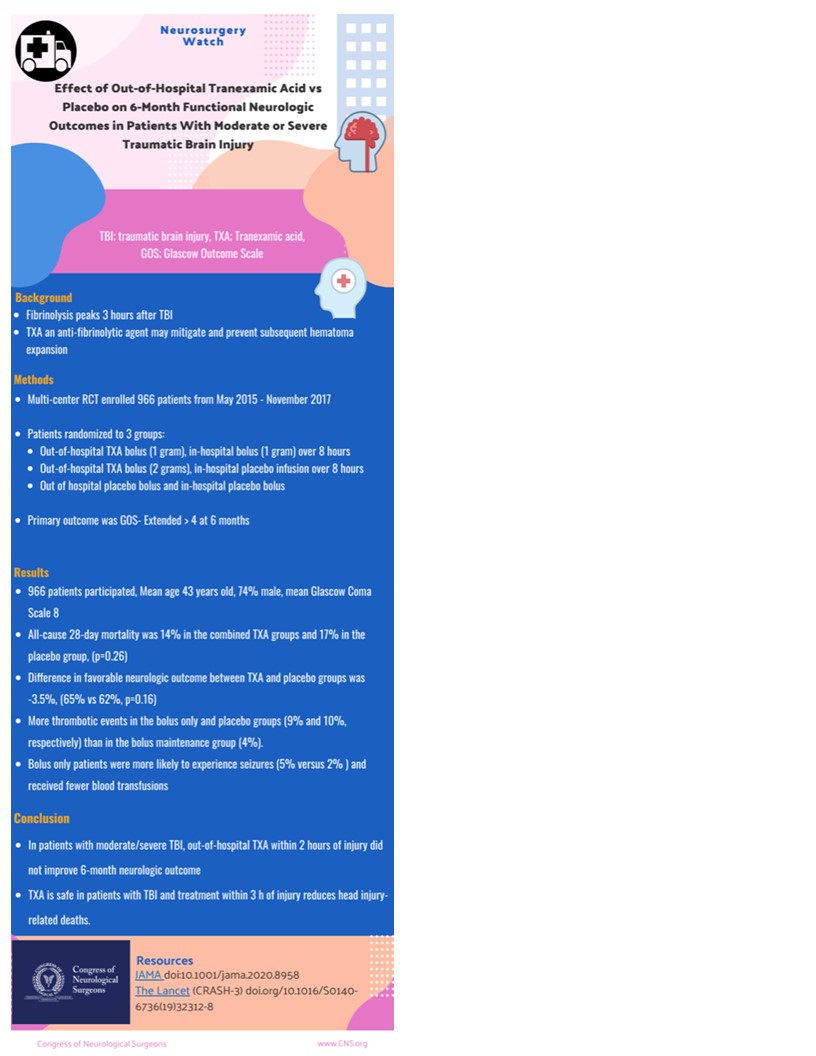Effect of Out-of-Hospital Tranexamic Acid vs Placebo on 6-Month Functional Neurologic Outcomes in Patients With Moderate or Severe Traumatic Brain Injury
- Background: Fibrinolysis peaks 3 hours after traumatic brain injury (TBI). Tranexamic acid (TXA), an anti-fibrinolytic agent, may mitigate this and prevent subsequent hematoma expansion.
- Randomized, multicenter clinical trial enrolling 966 patients at 20 trauma centers in the US and Canada, from May 2015 - November 2017.
- Patients were randomized to three groups:
- Out-of-hospital TXA bolus (1 gram) and in-hospital bolus (1 gram) over 8 hours (bolus maintenance group, n=312)
- Out-of-hospital TXA bolus (2 grams) and in-hospital placebo infusion over 8 hours (bolus only group, n=345)
- Out of hospital placebo bolus and in-hospital placebo bolus (placebo group, n=309)
- Treatment started within two hours of injury
- The two-gram bolus dosing was trialed to evaluate its potential usefulness in prehospital and military settings, while the one-gram bolus dosing was based on the CRASH-2 trial.
- Primary outcome was favorable neurologic function at 6 months (Glascow Outcome Scale- Extended > 4, corresponding to either moderate disability or good recovery).
- Ultimately, the two TXA groups were combined and compared to the placebo group to ensure adequate power.
- 1063 patients randomized, 966 participated (96 did not receive the study drug, one was excluded later).
- Mean age 43 years old, 74% male, mean Glascow Coma Scale 8
- The all-cause 28-day mortality was 14% in the combined TXA groups and 17% in the placebo group; this result was not statistically significant (p=0.26).
- This result differs from what the CRASH-3 authors found for patients with mild to moderate TBI (see link in Sources).
- The difference in the primary outcome of favorable neurologic outcome between the TXA groups and placebo group was -3.5%, (65% vs 62%, p=0.16 for benefit). This result was not statistically significant.
- There were more thrombotic events in the bolus only and placebo groups (9% and 10%, respectively) than in the bolus maintenance group (4%).
- Bolus only patients were also more likely to experience seizures (5% versus 2% in the other two groups), but they received fewer blood transfusions than patients in the other groups.

Source
JAMA
doi: 10.1001/jama.2020.8958
The Lancet (CRASH-3)
doi.org/10.1016/S0140-6736(19)32312-8